#Compsognathidae
Photo

Sinocalliopteryx gigas from the Early Cretaceous (Barremian, 124.6 Ma), China
#Sinocalliopteryx#Sinocalliopteryx gigas#Compsognathidae#Theropoda#Theropod#paleoart#palaeoart#art#paleontology#palaeontology#paleoblr#dinosaur#digital art
762 notes
·
View notes
Text
get a load of this guys

why would he make this so hard to read
13 notes
·
View notes
Text

Lil anthro Sinosauropterix!
#sinosauropteryx#furry#furry oc#dino oc#dinosaurs#dinoblr#dino#Compsognathidae#my art#mudkip i will cucify you if you tell anyone theres furry art on this blog
14 notes
·
View notes
Photo
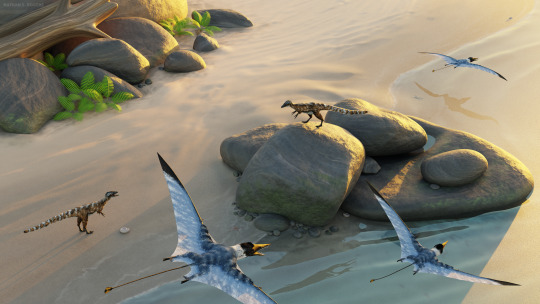
Solnhofen Sunrise 01
Late Jurassic, Europe
Compsognathus dinosaurs explore the early morning beach as Rhamphorhynchus pterosaurs fly by, perhaps returning from a night of fishing?
Made in Blender.
#compsognathidae#compsognathus#Rhamphorhynchus#rhamphorhynchoid#blender#3d#digital art#pterosaur#dinosaur#paleoart#paleontology#Jurassic#beach#morning
108 notes
·
View notes
Photo

Day 13: Compsognathus Mistaken though this is a chicken-sized theropod, now believe it’s a Turkey-sized adult, since the original latter is a juvenile. #Dinovember #Dinovember2022 #paleoart #sketchbookapp #artistoninstagram #compsognathus #compsognathuslongipes #compsognathidae #coelurosauria #theropoda #dinosauria #dinosaur #myart https://www.instagram.com/p/Ck7U1cJL9eM/?igshid=NGJjMDIxMWI=
#dinovember#dinovember2022#paleoart#sketchbookapp#artistoninstagram#compsognathus#compsognathuslongipes#compsognathidae#coelurosauria#theropoda#dinosauria#dinosaur#myart
7 notes
·
View notes
Text

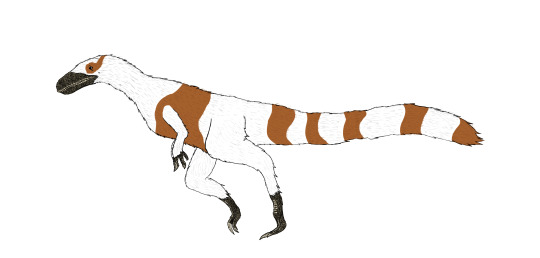
a new paleo-drawing after a looooong time, this time it's of Sinosauropteryx, enjoy! (sorry if there are any inaccuracies)
------
un nuevo paleo-dibujo despues de un laaaargoooo tiempo, esta vez es de Sinosauropteryx, disfruten! (lamento si es que hay algunas diferencias con el entendimiento actual del animal)
#my art#paleontology art#paleoart#paleontology#paleoblr#theropoda#theropod#sinosauropteryx#dinosauria#dinosaurs#dinosaur#compsognathidae#late cretaceous#cretaceous period#early cretaceous#feathered dinosaurs
0 notes
Text

Hoo boy, finally finished this piece. Spinosaurid with babies but the babies look nothing like the adult form. Inspired by that one paper that proposed compsognathidae was polyphyletic. A little snippet (about Scipionyx being closely related to spinosaurids) made me wonder about the possibility of spinosaurid babies looking completely different to adults. So I drew this. This piece is more than a little speculative tbh.
#art#my art#digital art#paleoart#paleontology#archosaurs#dinosaurs#theropods#megalosauroids#spinosaurs#queue
14 notes
·
View notes
Text



An fossil of Scipionyx samniticus which had remains of small intestine, hearts and guts. Found in 1981, and this is a baby dinosaur and still no adults found yet. One of Compsognathidae lived in Early Cretaceous Italy 🇮🇹.
23 notes
·
View notes
Note

if you interested there is some dinos who straight up honk like ducks yeah if you talk about them being related to birds, but there also this compsognathus thing what sounds like squirrel or kukabara(?) which makes me cry everytime i hear it😭😭😭😭

AWWW YEES Compsognathus! The baby! Ah yea I find it very easy to imagine them sounding quite weird. Birds as an animal group have such a huge vocalization range, it only makes sense that their relatives would have a similar range.
Imagine how weird some huge dinosaurs might have sounded if they had as complex vocalization as birds! The otherworldly sounds coming from a huge animal like that would be breathtaking to hear!
We actually discovered a fossilized ankylosaur larynx recently that suggests that they had bird like vocal cords! IT'S SO COOL!!!
I think the picture is of a Sinosauropteryx. But they're both in the Compsognathidae group so it's easy to mix them up. :>
29 notes
·
View notes
Text
Dinosaurios diminutos
Compsognathus
El compsognathus fue uno de los dinosaurios terópodos más pequeños con cadera de lagarto. Vivió hace entre 145 y 156 millones de años durante el jurásico tardío. Pertenecía a la familia Compsognathidae. El Sinosauropteryx y el juravenator eran primos del compsognathus.
Apariencia
La Apariencia del compsognathus era un dinosaurio pequeño delgado con un cuerpo largo y estrecho crecía hasta un metro de largo y pesaba entre uno y cuatro kilos . Eran probablemente del tamaño de un pavo moderno. Su cabeza medía unos 4 centímetros y tenía las patas delanteras cortas. Tenía dos dedos en las patas delanteras y tres en las traseras.
Corredores más rápidos
Los corredores más rápidos fue el compsognathus era un dinosaurio bípedo. Sus patas eran como las de un ave largas y delicadas. Eran muy rápidos podían alcanzar los 40 km por hora .Su velocidad era su única defensa ya que eran pequeños y en aquella época había muchos depredadores.
Cazadores
Los compsognathus eran carnívoros. Comían insectos gusanos lagartijas y mamíferos pequeños. Eran uno de los terópodos más inteligentes y más pequeños también se alimentaban de animales muertos.
Restos de fósiles
Los primeros fósiles de compsognathus fueron descubiertos en 1856. Los fósiles fueron adquiridos por el Dr.Josep Oberndorfer un coleccionista de fósiles. Johann A.Wagner nombró al dinosaurio ese mismo año. Una muestra más grande del compsognathus fue encontrada en una mina en el sureste de África en 1971 por el dueño de la cantera Louis Ghirardi.
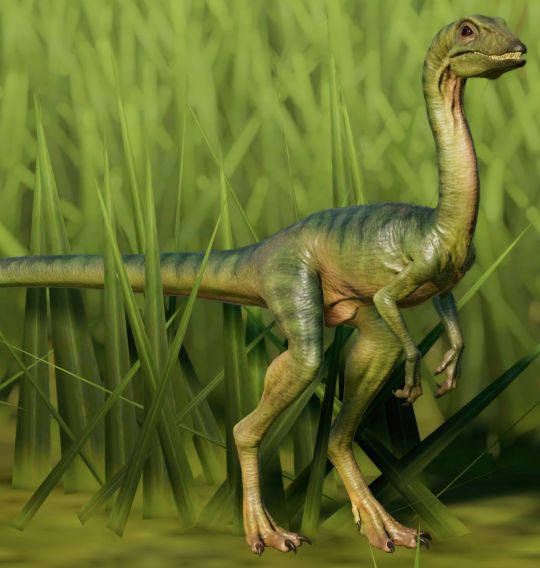
3 notes
·
View notes
Photo

April Fools 2022: The Aquatic Dinosaur That Wasn't
So, Spinosaurus wasn't technically the first known aquatic non-avian dinosaur.
That title instead temporarily went to Compsognathus corallestris.
While the idea that hadrosaurs and sauropods were wallowing swamp-dwellers had been completely abandoned at the start of the Dinosaur Renaissance, the new view of dinosaurs as active sophisticated animals led to a surprising aquatic hypothesis during the early days of this paleontological revolution.
A specimen of the small theropod Compsognathus discovered in southeastern France in the early 1970s was only the second skeleton ever found of this dinosaur, and came over a century after the first. It was initially thought to represent a new species since it was about 50% larger than the German specimen of Compsognathus longipes, and it seemed to have something very unusual going on with its hands – its forelimbs were somewhat poorly-preserved and distorted, and had traces of some sort of large fleshy structure around the hands that was interpreted as representing elongated three-fingered flippers used for swimming.
This wasn't necessarily as ridiculous of an idea as it might sound. Compsognathus lived during the Late Jurassic, about 150 million years ago, at a time when Europe was a group of islands in a shallow tropical sea. A semiaquatic dinosaur specialized to swim and dive, hunting the abundant aquatic prey in its environment, and easily able to island-hop all around the European archipelago seemed at least somewhat plausible, and reconstructions of fin-handed C. corallestris even appeared in several popular dinosaur books of the time.
But it didn't last.
Within just a few years doubt was being cast on this idea, and further studies of both known Compsognathus skeletons in the late 1970s and early 1980s concluded that C. corallestris was actually a fully-grown adult individual of the juvenile C. longipes. The French Compsognathus had normal-looking hands for its kind after all, with two large clawed fingers and a vestigial third finger, and the "flipper" impressions had just been ripples in the fossil slab.
For a long time after that the general view became that there just weren't any aquatic non-avian dinosaurs at all – but more recent discoveries like the new Spinosaurus material and Halszkaraptor are starting to suggest that some of these animals were much more at home in the water than previously thought.
Something resembling Compsognathus corallestris might still surprise us in the future.
———
Nix Illustration | Tumblr | Twitter | Patreon
#april fools#science illustration#retrosaurs#paleontology#paleoart#palaeoblr#compsognathus#compsognathidae#theropod#dinosaur#art#just keep swimming#no jokes this year; just a silly little swimmer who didn't make it into retromodern month#this is kind of a hybrid reconstruction with elements of the old fin-handed depictions but more modern-style anatomy
819 notes
·
View notes
Text
Hey fellow paleontology-loving friends! As y'all may know, a new possible member of the Compsognathidae family, Ubirajara jubatus was revealed to the public today (13/12/2020).
It apparently had a big feathered mane (hence the species name "jubatus") and unusual bird-of-paradise feathers sprouting out of its shoulders.

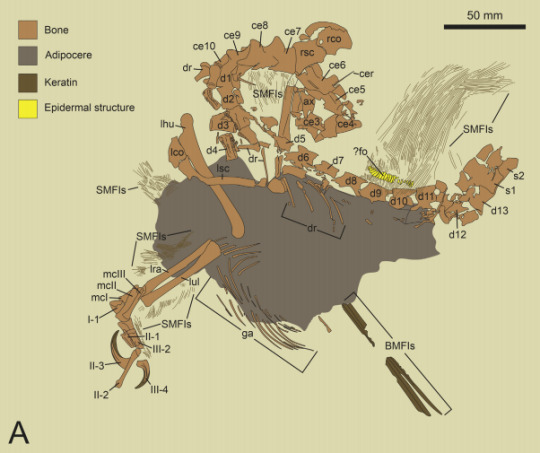
The HUGE issue that none of the news address is: this fossil is illegal. The researchers stole this fossil from Brazil. The main head paleontologist (David Martill) is literally banned from Brazil for violating the country's archeological transportation laws MANY times, stating that he "doesn't believe that fossils should be property of their original country, that they should be international".




David Martill, Eberhard Frey, Héctor Rivera Sylva and Robert Smyth (respectively) are NOT good paleontologists. They are colonialistic thieves that deserve to be in jail.
Ubirajara jubatus needs to be in Brazil. Not in a museum in fucking Germany.
Just warning y'all. Please reblog to inform others.
#rambling time!#paleontology#Brazil#Brasil#Criminal#Fossils#Paleoart#Paleonews#Ubirajara jubatus#Compsognathidae#therapod
3K notes
·
View notes
Photo
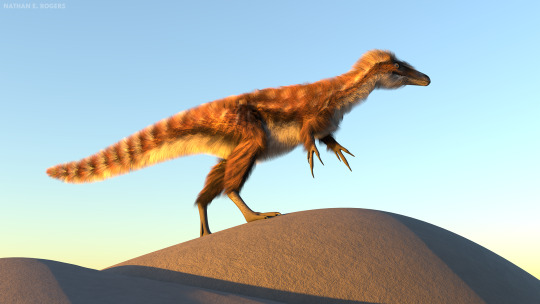
Compsognathus longipes 01
Late Jurassic, Europe
A small theropod dinosaur, depicted here ascending a seaside rock in the early morning.
Made in Blender.
#paleontology#paleoart#Mesozoic#Jurassic#3d#digital art#dinosaur#Nathan E. Rogers#natural history#compsognathidae#compsognathid#compsognathus#theropod#blender
66 notes
·
View notes
Text

#for the record i haven't read the paper yet in full so in case it is actually super wrong and stupid and i am spreading misinformation by#posting this and thus supporting an incorrect theory i sincerely apologize /hj#paleontology#scipionyx#carcharodontosauridae#compsognathidae#dinosaurs#paleomeme#paleoblr
164 notes
·
View notes
Photo

(Note: I am not a professional paleontologist or even biologist. I am just and amateur paleoartist and enthusiast. If my infos are off in some way, feel free to correct them ^^)
-
DINOCEMBER
11 - Ubirajara jubatus (from Tupi “lord of the spears”)
- Early Cretaceous (110 Ma BCE)
- Crato Formation, Ceará, Brazil
Named at the end of 2020, Ubirajara is one of the most impressive fossils found in Brazilian territory, being a member of the Compsognathidae, small theropods covered with proto-feathers - or "dino-fuzz" - related to raptors and tyrannosaurs, whose most famous members are China's Sinosauropteryx and Germany's Compsognathus itself. Described from a partial skeleton without the skull, Ubirajara presents impressions of its fuzz, having an apparent "mane" in its dorsal region and pairs of quills on its shoulders, similar to what is found in the current birds-of-paradise, probably used in courtship or to intimidate rivals.
The Crato Formation, as well as most of the formations in the Araripe Basin, would be the margins of a large saltwater lagoon, as well as a system of rivers surrounded by gymnosperms and some of the first flowering plants, being rich in fossil extract, especially of pterosaurs, and some curious animals, like the Enantiornithe Cratoavis. Unfortunately, Ubirajara, like other Brazilian fossils, is a target of international fossil trafficking, not having a single native author in the paper that describes it, with the team led by David Martill, a German paleontologist who smugled the Ubirajara fossil to Germany in 1995, and he cannot set foot on Brazilian territory for this and other crimes. Since its description, Ubirajara has been the target of campaigns for its repatriation, as well as other national fossils. I use this drawing as my collaboration for the campaign, and that so that this colonialist and criminal mentality ceases to exist in the paleontological community.
- Ubirajara’s color scheme inspired by a Vinaceous-breasted Amazon (Amazona vinacea) and a Vulturine Parrot (Pyrilia vulturina) and Cratoavis’ colors isnpired by a Black-thorated trogon (Trogon rufus). All of them are Brazilian birds
#UbirajaraBelongstoBR#ubirajara jubatus#ubirajara#theropod#compsognathus#compsognathidae#coelurosauria#feathered dinosaurs#Brazil#brazilian dinosaurs#dinocember2020#dinovember#Cratoavis#Crato Formation#Araripe Basin#creature design#creature art#creature concept#dinosaur#paleobiology#paleontology#paleoart#paleoillustration#sciart#science illustration
7 notes
·
View notes
Text

Day 13: Compsognathidae; Xunmenglong .
This is a newly discovered Compsognathid from last month in October.
#sketchbookapp#autodesk sketchbook#my art#compsognathidae#maniraptoriformes#maniraptoromorpha#tyrannoraptora#coelurosauria#avetheropoda#theropoda#ornithoscelida#dinosauria#draw dinovember#dinovember#paleoart
5 notes
·
View notes